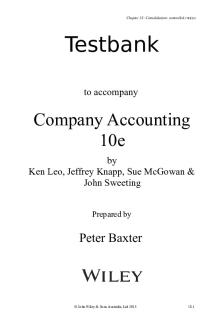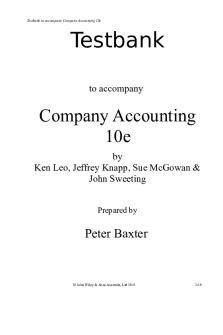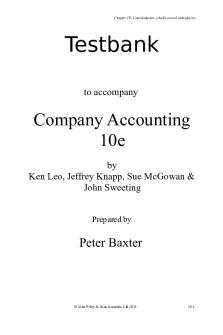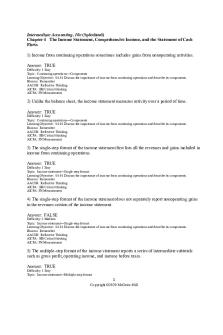Ch18 tb leo 10e - Ch18 tb leo 10e PDF

| Title | Ch18 tb leo 10e - Ch18 tb leo 10e |
|---|---|
| Course | Financial Accounting |
| Institution | Monash University |
| Pages | 16 |
| File Size | 186.5 KB |
| File Type | |
| Total Downloads | 80 |
| Total Views | 155 |
Summary
Ch18 tb leo 10e...
Description
Chapter 18: Consolidation: controlled entities
Testbank to accompany
Company Accounting 10e by Ken Leo, Jeffrey Knapp, Sue McGowan & John Sweeting Prepared by
Peter Baxter
© John Wiley & Sons Australia, Ltd 2015
18.1
Testbank to accompany Company Accounting 10e
© John Wiley & Sons Australia, Ltd 2015
Chapter 18: Consolidation: controlled entities Multiple-choice questions 1.
The entity that is represented by a single set of consolidated financial statements is: *a. b. c. d.
an economic entity. a parent entity. a subsidiary entity. a consolidated entity.
Correct answer: a Learning Objective 18.1 ~ explain the meaning of consolidated financial statements. 2.
AASB 10 Consolidated Financial Statements defines a ‘parent’ and a ‘subsidiary’ as which of the following? Parent An entity which is controlled by another entity. b. An entity which owns more than 20% of the voting shares of another entity. c. An entity that has one or more subsidiaries. *d. An entity that controls one or more entities.
a.
Subsidiary An entity that controls one or more entities. An entity which is owned partly by another entity. An entity which is controlled by a parent entity. An entity which is controlled by another entity.
Correct answer: d Learning Objective 18.1 ~ explain the meaning of consolidated financial statements.
3.
A single set of financial statements that combines the separate sets of financial statements for all entities within an economic entity, is known as: a. b. c. *d.
a concise financial report. a condensed financial report. combined financial statements. consolidated financial statements.
© John Wiley & Sons Australia, Ltd 2015
18.2
Chapter 18: Consolidation: controlled entities
Correct answer: d Learning Objective 18.1 ~ explain the meaning of consolidated financial statements.
© John Wiley & Sons Australia, Ltd 2015
18.3
Testbank to accompany Company Accounting 10e
4.
A group of entities comprised of Kerri Limited (parent entity), Georgia Limited (subsidiary entity) and Emily Limited (subsidiary entity) have the following inventory balances. - Kerri Limited $41 000 - Georgia Limited $14 000 - Emily Limited $12 000 Which of the following amounts is shown as the consolidated inventory balance in the consolidated financial statements? a. b. c. *d.
$12 000 $14 000 $26 000 $67 000
Correct answer: d Learning Objective 18.1 ~ explain the meaning of consolidated financial statements. 5.
The process of preparing consolidated financial statements requires that: *a. b. c. d.
no adjustments be made to the individual financial statements or ledger accounts of the entities in the group. adjusting journal entries be recorded in the ledger accounts of the subsidiaries only. accruals of expenses and revenues be recorded directly into the retained earnings account of the parent entity. adjusting journal entries be recorded in the ledger accounts of the parent only.
Correct answer: a Learning Objective 18.1 ~ explain the meaning of consolidated financial statements. 6.
When one entity controls another entity, the business combination results in which of the following types of relationship? *a. b. c. d.
Parent–subsidiary Investor–investee Investor–associate Parent–child
Correct answer: a Learning Objective 18.1 ~ explain the meaning of consolidated financial statements.
© John Wiley & Sons Australia, Ltd 2015
18.4
Chapter 18: Consolidation: controlled entities
7.
The process of preparing the combined financial statements of a group of entities is known as: a. b. c. *d.
aggregation. combination. accumulation. consolidation.
Correct answer: d Learning Objective 18.1 ~ explain the meaning of consolidated financial statements. 8.
The reasons for the preparation of consolidated financial statements include which of the following? a. b. c. *d.
Reporting of risks and benefits Comparable information Supply of relevant information All of the above
Correct answer: d Learning Objective 18.1 ~ explain the meaning of consolidated financial statements. 9.
For the purposes of consolidated financial reporting, a group is: a. *b. c. d.
an investor and its investees. a parent entity and all its subsidiaries. an entity that has one or more subsidiaries. an entity that is controlled by a parent.
Correct answer: b Learning Objective 18.1 ~ explain the meaning of consolidated financial statements.
10.
A subsidiary is an entity that: a. b. c. *d.
has significant influence over a parent entity. exercises control over a parent entity. has the power to control a parent entity. is controlled by another entity.
Correct answer: d Learning Objective 18.1 ~ explain the meaning of consolidated financial statements.
© John Wiley & Sons Australia, Ltd 2015
18.5
Testbank to accompany Company Accounting 10e
11. The key characteristic that determines when consolidated financial statements should be prepared is: a. *b. c. d.
the existence of transactions between the entities. control. substance over form. significant influence.
Correct answer: b Learning Objective 18.2 ~ discuss the meaning and application of the criterion of control.
12.
In a consolidated group of entities, control over the subsidiaries in the group: *a. b. c. d.
may not be shared control. can be shared with other entities. requires 100% ownership of the subsidiaries’ shares. can exist where the rights are purely protective rights.
Correct answer: a Learning Objective 18.2 ~ discuss the meaning and application of the criterion of control. 13.
According to AASB 10 Consolidated Financial Statements, which of the following factors indicate the existence of control? I.
IV.
Possessing existing rights that give the current ability to direct the relevant activities. Shared power in the governance of financial and operating policies of another entity so as to obtain benefits. The power to have significant influence over the operating policies of an entity so as to obtain benefits. Ownership of more than 50% of the voting rights in the subsidiary.
a. *b. c. d.
I, II and III only I and IV only II and IV only IV only
II. III.
Correct answer: b Learning Objective 18.2 ~ discuss the meaning and application of the criterion of control.
© John Wiley & Sons Australia, Ltd 2015
18.6
Chapter 18: Consolidation: controlled entities
14.
The equity in a subsidiary not attributable to a parent is known as a/an: *a. b. c. d.
non-controlling interest. attributable interest. non-parent interest. external interest.
Correct answer: a Learning Objective 18.2 ~ discuss the meaning and application of the criterion of control.
15.
Which of the following is not one of the three elements of control according to AASB 10 Consolidated Financial Statements? a. *b. c. d.
The ability to use power over the investee to affect the amount of the investor’s returns. Dominating the decision making of the investee. Power over the investee. Exposure, or rights, to variable returns from involvement with the investee.
Correct answer: b Learning Objective 18.2 ~ discuss the meaning and application of the criterion of control. 16.
In the context of control, which of the following is correct regarding rights? a. b. c. *d.
They must be protective rights. They must arise from a legal contract. They must arise as a result of future events. They must be substantive rights.
Correct answer: d Learning Objective 18.2 ~ discuss the meaning and application of the criterion of control.
17.
Rights to variable returns from an investee include: a. b. c. *d.
from economies of scale. remuneration from provision of services. returns from denying or regulating access to a subsidiary’s assets. all of the above.
Correct answer: d Learning Objective 18.2 ~ discuss the meaning and application of the criterion of control.
© John Wiley & Sons Australia, Ltd 2015
18.7
Testbank to accompany Company Accounting 10e
18.
At balance date, Company A has 40% of the voting rights in Company B. In addition Company A holds potential voting rights in Company B amounting to 6% that are currently exercisable, and a further 9% of voting rights in Company B that can be exercised in two years’ time. Which of the following statements is correct? a. *b. c. d.
Consolidated financial statements must be prepared for Company A and B in the current year. Consolidated financial statements need not be prepared for Company A and B for the current year. Consolidated financial statements must be prepared as Company A controls Company B at balance date. Consolidated financial statements must be prepared as Company A has more than half of the voting rights in Company B at balance date.
Correct answer: b Learning Objective 18.2 ~ discuss the meaning and application of the criterion of control. 19.
Eastpac Bank has lent Alexandra Ltd $500 000. Part of the loan contract prevents Alexandra from borrowing money in the future from other banks without the permission of Eastpac. As a result of this relationship: a. b. *c. d.
Eastpac Bank is regarded as a parent entity of Alexandra Limited. Alexandra Limited is regarded as a subsidiary of Eastpac Bank. a parent–subsidiary relationship does not exist between these two parties. a parent–subsidiary relationship is regarded as existing between these two parties as Eastpac Bank is able to direct the relevant activities of Alexandra Limited.
Correct answer: c Learning Objective 18.2 ~ discuss the meaning and application of the criterion of control. 20.
When deciding whether or not one entity controls another entity: a. *b. c. d.
the controlling entity must have exercised its power to control. it is sufficient that the controlling entity has the capacity to control. the controlling entity must be actively involved in the decision making of the other entity. the controlling entity must have exerted its control over the financing policies of the other entity.
Correct answer: b Learning Objective 18.2 ~ discuss the meaning and application of the criterion of control.
© John Wiley & Sons Australia, Ltd 2015
18.8
Chapter 18: Consolidation: controlled entities
21.
According to AASB 10 Consolidated Financial Statements, all parent entities are required to present consolidated statements unless which of the following conditions apply to them? I II III IV
a. b. *c. d.
The parent is a wholly owned subsidiary. The parent is a partly owned subsidiary and its other owners do not object to the non-presentation of consolidated financial statements. The parent’s debt or equity securities are traded in a public market. The parent is not in the process of applying to issue any securities in a public market. I and II only I, II and III only I, II and IV only I, II, III and IV
Correct answer: c Learning Objective 18.3 ~ discuss which entities should prepare consolidated financial statements.
22.
Juliet Ltd is a listed public company and has an 60% controlling interest in Marley Pty Ltd. Marley Pty Ltd is the parent of Butterscotch Pty Ltd. In which of the following situations will Marley Pty Ltd not be required to prepare consolidated financial statements? a. *b. c. d.
If Marley Pty Ltd prepares separate financial statements that comply with IFRS. If the other owners of Marley Pty Ltd have consented to the non-preparation of consolidated financial statements. Where it is likely that there are external users dependant on the information. Marley Pty Ltd would never be required to prepare consolidated financial statements.
Correct answer: b Learning Objective 18.3 ~ discuss which entities should prepare consolidated financial statements.
© John Wiley & Sons Australia, Ltd 2015
18.9
Testbank to accompany Company Accounting 10e
23.
Kowloon Limited is an entity listed in Hong Kong. Kowloon Limited holds a 100% investment in Aussie Pty Ltd, an Australian based company, who in turn holds a 90% interest in Skippy Pty Ltd. Aussie Pty Ltd and the Aussie group (comprising Aussie and Skippy) are both non-reporting entities. Which of the following statements is correct? a. *b. c. d.
Aussie Pty Ltd will be required to prepare consolidated financial statements as the ultimate Australian parent. Aussie Pty Ltd will not be required to prepare consolidated financial statements as they are a non-reporting entity. Aussie Pty Ltd will be required to prepare consolidated financial statements only if directed to do so by ASIC. Aussie Pty Ltd will not be required to prepare consolidated financial statements as Kowloon is a listed foreign entity.
Correct answer: b Learning Objective 18.3 ~ discuss which entities should prepare consolidated financial statements.
24.
Which of the following is not included in the definition of an investment entity as per IFRS 10 Consolidated Financial Statements? *a.
Measures and evaluates the performance of substantially all of its investments on a cost basis. b. Measures and evaluates the performance of substantially all of its investments on a fair value basis. c. Commits to its investors that its business purpose is to invest funds solely for returns from capital appreciation or investment income. d. Obtains funds from one or more investors for the purpose of providing those investors with investment management services. Correct answer: a Learning Objective 18.4 ~ explain the nature of an investment entity.
25.
Which of the following statements is correct? a. b. c. *d.
The legal acquirer under AASB 3 and the accounting acquirer under AASB 10 do not have to be the same entity. The entity identified under AASB 10 as the parent will be the acquirer under AASB 3. The legal acquirer is determined under AASB 3 as the entity that issues the equity instruments. The accounting acquirer is the entity that becomes the controlling entity.
Correct answer: d Learning Objective 18.5 ~ outline the relationship between a parent and an acquirer in a business combination.
© John Wiley & Sons Australia, Ltd 2015
18.10
Chapter 18: Consolidation: controlled entities
26.
Two entities A Limited and B Limited together form a third entity, C Limited. C Limited acquires A Limited and B Limited. In this situation, AASB 3 Business Combinations, adjudges that: a. b. c. *d.
A Limited and B Limited cease to exist and C Limited is the acquirer. the combined A Limited and B Limited, is the acquirer of C Limited. C Limited is considered to be the acquirer. C Limited is not to be considered to be the acquirer.
Correct answer: d Learning Objective 18.5 ~ outline the relationship between a parent and an acquirer in a business combination. 27.
Which of the following is not one of the factors in AASB 3 Business Combinations that guide the identification of the acquirer where 2 companies combine to form a new company? *a. The entity that has the smaller fair value. b. The entity that has a significantly greater fair value. c. The entity whose management is able to dominate the business combination. d. The entity that gives up the cash or other assets where equity instruments are exchanged for cash or other assets.
Correct answer: a Learning Objective 18.5 ~ outline the relationship between a parent and an acquirer in a business combination. 28.
Where an entity controls another entity but holds less than half of the other entity’s voting rights, AASB 12 Disclosure of Interests in Other Entities, requires which of the following disclosures be made? a. b. *c. d.
The reasons why the ownership of the investee does not constitute control. The nature of the relationship between the investor and investee. The significant judgements and assumptions it has made in determining the nature of the interest in the other entity. The amount of any repayments of borrowings between the investor and investee during the period.
Correct answer: c Learning Objective 18.6 ~ explain the differences in disclosure requirements between single entities and consolidated entities.
© John Wiley & Sons Australia, Ltd 2015
18.11
Testbank to accompany Company Accounting 10e
29.
According to AASB 12 Disclosure of Interests in Other Entities, an entity that has been designed so that voting or similar rights are not the dominant factor in deciding who controls the entity is known as a: a. *b. c. d.
controlling entity. structured entity. dominant entity. rights entity.
Correct answer: b Learning Objective 18.6 ~ explain the differences in disclosure requirements between single entities and consolidated entities. 30.
Where a non-controlling interest exists in a subsidiary, AASB 12 Disclosure of Interests in Other Parties requires parent entities to disclose which of the following for each such subsidiary? I II III IV
Summarised financial information about each subsidiary. The proportion of ownership interests held by non-controlling interests. If the subsidiary is not wholly owned, the names of all other members. The country of incorporation of subsidiaries.
*a. b. c. d.
I, II and IV only II, III and IV only I and IV only I, II, III and IV
Correct answer: a Learning Objective 18.6 ~ explain the differences in disclosure requirements between single entities and consolidated entities.
© John Wiley & Sons Australia, Ltd 2015
18.12
Chapter 18: Consolidation: controlled entities
True/false questions 31.
A subsidiary is defined in AASB 10 Consolidated Financial Statements as a company that is controlled by another entity.
The statement is false. A subsidiary does not need to be a company, but can take another entity form, such as an unincorporated partnership. Learning Objective 18.1 ~ explain the meaning of consolidated financial statements. 32.
The financial statements of a group are referred to as consolidated financial statements.
The statement is true. The combined financial statements of a parent and its subsidiaries (referred to as a group) are referred to as consolidated financial statements. Learning Objective 18.1 ~ explain the meaning of consolidated financial statements.
33.
The consolidation process involves making adjustments to the individual financial statements and ledger accounts of the entities within the group.
The statement is false. Consolidation adjustments are not made to the individual financial statements, but are made on a worksheet or spreadsheet for the purpose of preparing the consolidated financial statements. Learning Objective 18.1 ~ explain the meaning of consolidated financial statements.
34.
Control is the criterion for determining whether a parent-subsidiary relationship exists.
The statement is true. A subsid...
Similar Free PDFs

Ch18 tb leo 10e - Ch18 tb leo 10e
- 16 Pages

Ch24 tb leo 10e - Ch24 tb leo 10e
- 15 Pages

Ch19 tb leo 10e - Ch19 tb leo 10e
- 17 Pages

ch21 sm leo 10e
- 107 Pages

Brinkley 15 tb ch18 - hello
- 20 Pages

Spilker 10e Chapter 01 TB
- 17 Pages

Spilker 10e Chapter 02 TB
- 16 Pages

Spilker 10e Chapter 04 TB
- 18 Pages

Spilker 10e Chapter 06 TB
- 17 Pages

Spilker 10e Chapter 05 TB
- 21 Pages

Spiceland 10e TB Chapter 04 Final
- 105 Pages

Ch18
- 158 Pages

Ch18
- 23 Pages
Popular Institutions
- Tinajero National High School - Annex
- Politeknik Caltex Riau
- Yokohama City University
- SGT University
- University of Al-Qadisiyah
- Divine Word College of Vigan
- Techniek College Rotterdam
- Universidade de Santiago
- Universiti Teknologi MARA Cawangan Johor Kampus Pasir Gudang
- Poltekkes Kemenkes Yogyakarta
- Baguio City National High School
- Colegio san marcos
- preparatoria uno
- Centro de Bachillerato Tecnológico Industrial y de Servicios No. 107
- Dalian Maritime University
- Quang Trung Secondary School
- Colegio Tecnológico en Informática
- Corporación Regional de Educación Superior
- Grupo CEDVA
- Dar Al Uloom University
- Centro de Estudios Preuniversitarios de la Universidad Nacional de Ingeniería
- 上智大学
- Aakash International School, Nuna Majara
- San Felipe Neri Catholic School
- Kang Chiao International School - New Taipei City
- Misamis Occidental National High School
- Institución Educativa Escuela Normal Juan Ladrilleros
- Kolehiyo ng Pantukan
- Batanes State College
- Instituto Continental
- Sekolah Menengah Kejuruan Kesehatan Kaltara (Tarakan)
- Colegio de La Inmaculada Concepcion - Cebu


